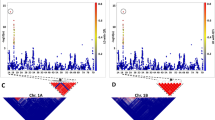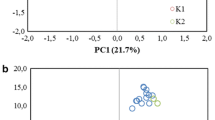Abstract
Linkage disequilibrium (LD) at the adh1 locus was examined in two sets of maize inbreds. A set of 32 was chosen to represent most of the genetic diversity in the cultivated North American elite maize breeding pool. A second set of 192 inbreds was chosen to sample more deeply the two major heterotic groups in elite maize germplasm. Analysis of several loci in the vicinity of the adh1 gene shows that LD as measured by D′ and r2 extends greater than 500 kbp in this germplasm. The presence of this exceptionally long segment of high LD may be suggestive of selection acting on one of the genes in the vicinity of adh1 or of a locally reduced rate of recombination.




Similar content being viewed by others
References
Altschul SF, Madden TL, Schaffer AA, Zhang J, Zhang Z, Miller W, Lipman DJ (1997) Gapped Blast and PSI-Blast: a new generation of protein database search programs. Nucleic Acids Res 25:3389–3402
Ananiev EV, et al (1997) Oat–maize chromosome addition lines: a new system for mapping the maize genome. Proc Natl Acad Sci USA 94:3524–3529
Araki E (1999) Identification of genetic loci affecting amylose content and agronomic traits on chromosome 4A of wheat. Theor Appl Genet 98:977–984
Bonnen PE, Wang PJ, Kimmel M, Chakraborty R, Nelson DL (2002) Haplotype and linkage disequilibrium architecture for human cancer-associated genes. Genome Res 12:1846–1853
Brenner S, Johnson M, Bridgham J, Golda G, Lloyd DH, Johnson D, Luo S, McCurdy S, Foy M, Ewan M, Roth R, George D, Eletr S, Albrecht G, Vermaas E, Williams SR, Moon K, Burcham T, Pallas M, DuBridge RB, et al (2000) Gene expression analysis by massively parallel signature sequencing (MPSS) on microbead arrays. Nat Biotechnol 18:630–634
Buckler ES IV, Thornsberry JM (2002) Plant molecular diversity and applications to genomics. Curr Opin Plant Biol 5:107–111
Ching A, Caldwell K, Jung M, Dolan M, Smith O, Tingey S, Morgante M, Rafalski A (2002) SNP frequency, haplotype structure and linkage disequilibrium in elite maize inbred lines. BMC Genet 3:19
Dooner HK (2002) Extensive interallelic polymorphisms drive meiotic recombination into a crossover pathway. Plant Cell 14:1173–1183
Dooner HK, Martinez-Ferez IM (1997) Recombination occurs uniformly within the bronze gene, a meiotic recombination hotspot in the maize genome. Plant Cell 9:1633–1646
Flint-Garcia S, Thornsberry J, Buckler EI (2003) Structure of linkage disequilibrium in plants. Annu Rev Plant Biol 54:357–374
Fu H, Dooner HK (2002a) Intraspecific violation of genetic colinearity and its implications in maize. Proc Natl Acad Sci USA 99:9573–9578
Fu H, Dooner HK (2002b) Recombination rates between adjacent genic and retrotransposon regions in maize vary by 2 orders of magnitude. Proc Natl Acad Sci USA 99:1082–1087
Gardiner J, Schroeder S, Polacco ML, Sanchez-Villeda H, Fang Z, Morgante M, Landewe T, Fengler K, Useche F, Hanafey M, Tingey S, Chou H, Wing R, Soderlund C, Coe EH Jr (2004) Anchoring 9,371 maize expressed sequence tagged unigenes to the bacterial artificial chromosome contig map by two-dimensional overgo hybridization. Plant Physiol 134:1317–1326
Gaut BS, Clegg MT (1993) Molecular evolution of the adh1 locus in the genus Zea. Proc Natl Acad Sci USA 90:5095–5099
Goldstein DB, Weale ME (2001) Population genomics: linkage disequilibrium holds the key. Curr Biol 11:R576-R579
Gut IG (2001) Automation in genotyping single nucleotide polymorphisms. Hum Mutat 17:475–492
Hill W, Robertson A (1968) Linkage disequilibrium in finite populations. Theor Appl Genet 38:226–231
Jorde LB (2000) Linkage disequilibrium and the search for complex disease genes. Genome Res 10:1435–1444
Lee M, Sharopova N, Beavis WD, Grant D, Katt M, Blair D, Hallauer A (2002) Expanding the genetic map of maize with the intermated B73 × Mo17 (IBM) population. Plant Mol Biol 48:453–461
Lewontin R (1964) The interaction of selection and linkage. I. General considerations; heterotic models. Genetics 49:49–67
Lubberstedt T (1998) Comparative quantitative trait loci mapping of partial resistance to Puccinia sorghi across four populations of European flint maize. Phytopathology 88:1324–1329
Myers B, Tingey S, Morgante M (2001) Abundance, distribution, and transcriptional activity of repetitive elements in the maize genome. Genome Res 11:1660–1676
Palaisa KA, Morgante M, Williams M, Rafalski A (2003) Contrasting effects of selection on sequence diversity and linkage disequilibrium at two phytoene synthase loci. Plant Cell 15:1795–1806
Pritchard JK, Stephens M, Donnelly P (2000) Inference of population structure using multilocus genotype data. Genetics 155:945–959
Rafalski A (2002) Applications of single nucleotide polymorphisms in crop genetics. Curr Opin Plant Biol 5:94–100
Rafalski A, Morgante M (2004) Corn and humans: recombination and linkage disequilibrium in two genomes of similar size. Trends Genet 20:103–111
Reich DE, Cargill M, Bolk S, Ireland J, Sabeti PC, Richter DJ, Lavery T, Kouyoumjian R, Farhadian SF, Ward R, Lander ES (2001) Linkage disequilibrium in the human genome. Nature 411:199–204
Remington DL, Thornsberry JM, Matsuoka Y, Wilson LM, Whitt SR, Doebley J, Kresovich S, Goodman MM, Buckler EST (2001) Structure of linkage disequilibrium and phenotypic associations in the maize genome. Proc Natl Acad Sci USA 98:11479–11484
Rozas J, Rozas R (1999) DnaSP version 3: an integrated program for molecular population genetics and molecular evolution analysis. Bioinformatics 15:174–175
Rozen S, Skaletsky H (2000) Primer3 on the WWW for general users and for biologist programmers. In: Krawetz S, Misener S (eds) Bioinformatics methods and protocols: methods in molecular biology. Humana Press, Totowa
Shi MM (2001) Enabling large-scale pharmacogenetic studies by high-throughput mutation detection and genotyping technologies. Clin Chem 47:164–172
Smith TFAW (1981) Identification of common molecular subsequecnes. J Mol Biol 147:195–197
Solovyev VV (2001) Statistical approaches in Eukaryotic gene prediction. In: Balding D, et al (eds) Handbook of statistical genetics. Wiley, New York, pp 83–127
Tajima F (1989a) DNA polymorphism in a subdivided population: the expected number of segregating sites in the two-subpopulation model. Genetics 123:229–240
Tajima F (1989b) The effect of change in population size on DNA polymorphisms. Genetics 123:585–595
Taramino G, Tingey S (1996) Simple sequence repeats for germplasm analysis and mapping in maize. Genome 39:277–287
Tenaillon MI, Sawkins MC, Long AD, Gaut RL, Doebley JF, Gaut BS (2001) Patterns of DNA sequence polymorphism along chromosome 1 of maize (Zea mays ssp.mays L.). Proc Natl Acad Sci USA 98:9161–9166
Tenaillon MI, Sawkins MC, Anderson LK, Stack SM, Doebley J, Gaut BS (2002) Patterns of diversity and recombination along chromosome 1 of maize (Zea mays ssp.mays L.). Genetics 162:1401–1413
Tikhonov AP, SanMiguel PJ, Nakajima Y, Gorenstein NM, Bennetzen JL, Avramova Z (1999) Colinearity and its exceptions in orthologous adh regions of maize and sorghum. Proc Natl Acad Sci USA 96:7409–7414
Weiss K, Terwilliger J (2000) How many diseases does it take to map a gene with SNPs? Nat Genet 26:151–157
White SE, Doebley JF (1999) The molecular evolution of terminal ear 1, a regulatory gene in the genus Zea. Genetics 153:1455–1462
Acknowledgements
We thank Steve Wall, Mike Hanafey, Stan Luck, Romeo Hubner, Nancy Caraher, Howie Smith, David Meyer, Marianna Faller, and Michael Gore for helpful advice and analysis support. We also thank Ed Buckler help with data analysis and comments on the manuscript.
Author information
Authors and Affiliations
Corresponding author
Additional information
Communicated by F. Salamini
Electronic Supplementary Material
This material is also available at http://bioinf.dimi.uniud.it
Rights and permissions
About this article
Cite this article
Jung, M., Ching, A., Bhattramakki, D. et al. Linkage disequilibrium and sequence diversity in a 500-kbp region around the adh1 locus in elite maize germplasm. Theor Appl Genet 109, 681–689 (2004). https://doi.org/10.1007/s00122-004-1695-8
Received:
Accepted:
Published:
Issue Date:
DOI: https://doi.org/10.1007/s00122-004-1695-8




